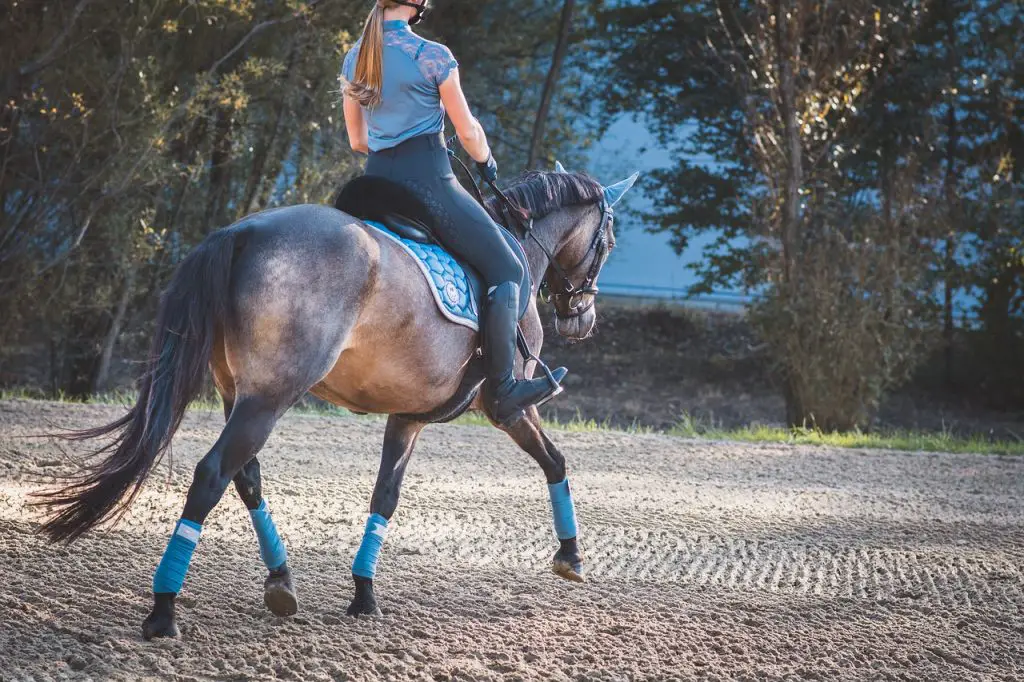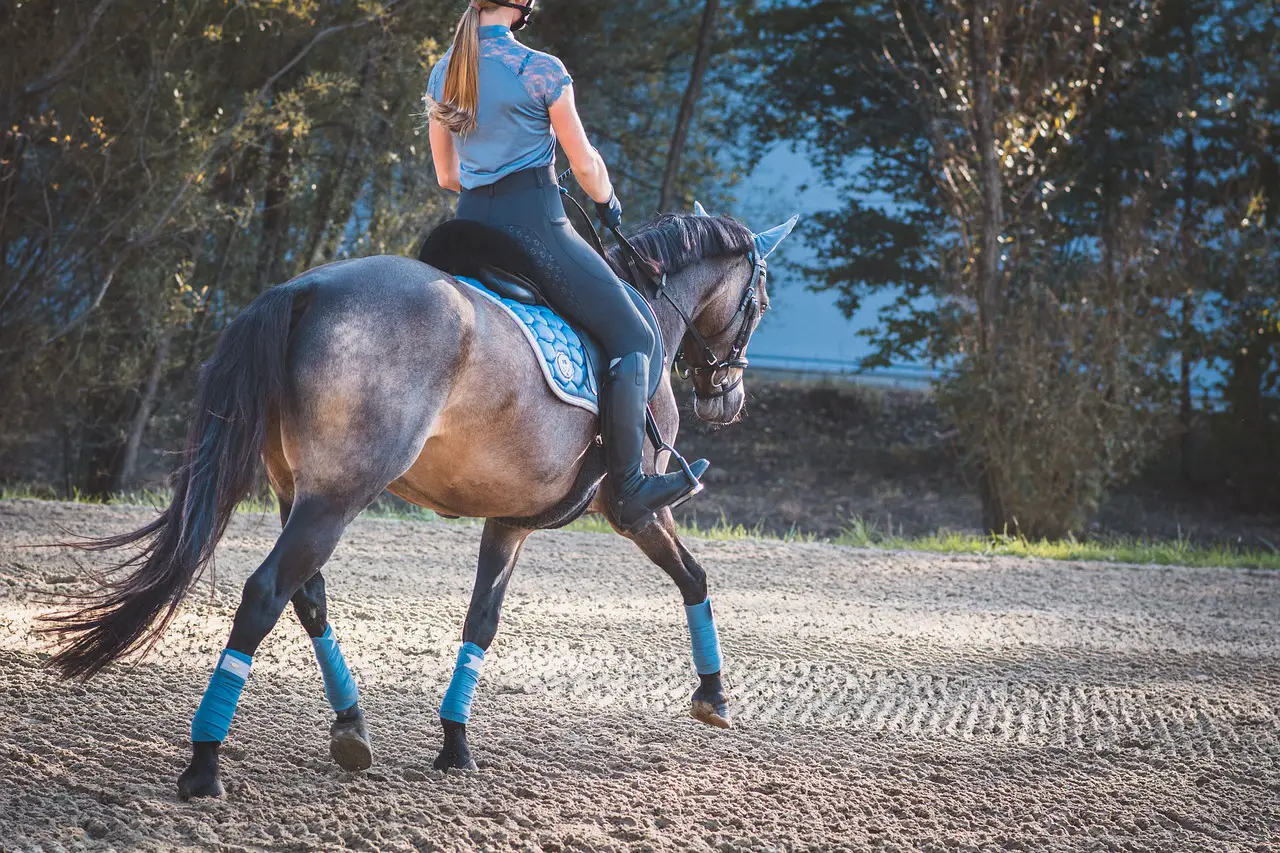Last Updated on March 24, 2022 by Allison Price
Most dressage riders aim to ride at an advanced level and maybe one day get into the centerline tailcoat. Although most riders will never compete at Grand Prix level, it is possible to still teach your horse advanced movements in your own home.
Piaffe is perhaps the most difficult move to teach horses.

What is the piaffe, you ask? How can you ride this movement? What are the most common errors?
Learn how to train and ride the piaffe.
What is the piaffe?
The FEI dressage rules define the piaffe as:
“A highly collected, cadenced and elevated diagonal movement that gives the impression of being in place. Horse’s back is flexible and elastic. The horse’s hindquarters are lowered. The haunches are well-engaged. This gives the horse great mobility, freedom, lightness and mobility to the shoulders, forehand, and forehand. With spring and an even pace, each pair of diagonal legs are raised and then returned to the ground in an alternate fashion.
Piaffe appears for the first time in Intermediare II dressage testing. This level allows the steps to move forward slightly, but not “on the spot.”
What makes a piaffe good?
In addition to meeting the FEI requirements, a horse must be able to move energetically between the diagonal pairs of legs, and show excellent cadence. He should have a flexible back and be able to sit on his hind legs with his neck elevated.
The horse’s nose should remain slightly in front of the vertical throughout the exercise. The horse’s front foot should be lifted so that it reaches to the center of each cannon bone. The horse’s forearms must be straight.
The rider of the piaffe should be tall and straight. They should also keep their neck extended while riding. The rider should carry their hands slightly higher, but not pull back. Their elbows should rest softly on the sides of the rider.
Every horse is unique to a certain extent. Some horses find the piaffe an easy and natural exercise. The amount of lowering the neck and the position of the shoulders will depend on the individual’s temperament and their conformation.
Common problems
The most common problem with piaffes is tension.
Common piaffe faults include:
- Loss of rhythm, the horse trots or walks
- Loss of rhythm, the steps are no longer in clear diagonals
- Horses travel forward rather than staying put.
- Swinging side to side
- Crossing the hind legs or front legs
- Triangulation
Triangulation is a serious fault in piaffe. Triangulation occurs when the horse’s hind and front legs are crowded under the horse’s body. This creates an inverted triangle. The triangle’s point is created by the horse’s feet, while the horse’s belly and legs form the base.
Troubleshooting
Every problem that the piaffe causes is usually related to the basic training of the horse.
Loss of rhythm
The horse will lose rhythm if you ask him too many things too quickly, or if you try to introduce piaffe too early for his level of training.
The transitions between the piaffe and the horse should be as smooth as possible. If rhythm is lost, you can go back to the collected trot again and try again.
Flat steps, energy loss, triangulation
The horse could stop moving or go backwards if you have too much control. Your hands should not hold the horse in place. They should only make small movements.
Go back to work on basic throughness of the horse.
Steps to Swinging
The reason the horse swings during the piaffe is usually that his hind legs trail behind him rather than being under his body. If the horse crosses his legs during the piaffe, it may be due to conformation or because the horse doesn’t have the self-carriage required for a good one.
You can correct this fault by enhancing the horse’s carrying ability using lateral to encourage him to move more beneath his body.
Is your horse ready for the piaffe?
Piaffe is one of the most difficult dressage movements you can teach your horse. Before you can start working at this level, your horse must be physically fit enough to perform self-carriage with true collection.
The horse must respond to the rider’s seat aids , the half-halt and must be able to relax when being asked to do this demanding move.
The horse must be able to move forward on his own without your assistance. This is important as the piaffe hand aids you use must not prevent the horse from using his hind legs. This is not always easy for all horses.
Your horse should not be expected to master piaffe. Some horses are naturally skilled at piaffe and can do it quickly. Others may need to be taught. Your horse may not be strong enough to do a piaffe right away, so allow your horse to practice forward travel until you are able to give him more weight.
How to train the piaffe
Start by riding in shoulder-fore both directions. This improves your horse’s flexibility and keeps him on your aids. You’re basically riding transitions. The trot is broken into shorter strides and the trot is then extended again. This exercise helps develop flexibility and strengthens the horse’s reins.
The horse is also kept straight by the shoulder-fore position. He doesn’t trail his hocks behind him or come wide behind the other horses, which are common problems with piaffes.
To reduce the steps
- To keep the energy flowing, you can use shoulder-fore while pushing the horse with your legs.
- To resist a little bit from the reins, close your fingers but don’t pull back.
- You ask the horse to “go”, by holding your hand with your other hand and asking him to move with your legs, you’re asking him to slow down his steps.
After taking a few steps, you can return to an engaged trot in shouldering-in. Before you continue the exercise, make sure the horse is in proper self-carriage. Keep everything as fluid as possible.
Gradually increase your request for steps. Don’t push the horse if he becomes upset or tense. Instead, just go back to the collected trot, and then ride shoulder-in asking for lots impulsion, and strengthening the horse’s self-carriage.
Focus on the fluency and rhythm when you ride the transitions between piaffe and piaffe.
Essentially, that’s it!
The long-term process of teaching piaffes is not an easy one. The piaffe can take anywhere from six months to two to be ready for competition. It doesn’t matter if you don’t plan to compete, it can take as long as two years for a horse to be physically strong enough for home use.
Training exercises that are useful
These are some useful training exercises to help you teach the piaffe.
Exercise 1: Half-steps down one side of the arena
- From M to R, ride down the long side in shoulder forward.
- To shorten the horse’s steps, make small half-halts as you reach R. Keep the rhythm going and have the horse move forward in your hands. The trot should feel higher than it does lower.
- You should get the horse back in the trot before you go to B. This will prevent you from being tempted to ask too much for piaffe during this stage of horse training.
- You can repeat the exercise on the other side. Make sure you practice the same on both reins to make your horse stronger.
Exercise #2: Half-steps around a circle of 20m
- Take a steady trot and pick up a 20-meter circle. Then, place the horse in shoulder-fore.
- You can use a half-halt at two points in your circle (A and C, or the centerline) to reduce the horse’s stride length for five or six steps.
- You will now ride back in a steady trot, shoulder-fore. Try to maintain a smooth transition.
- Keep your stride shortening after you reach the half-mark.
You can also include the quarter points of your circle as your horse gets stronger.
Exercise #3: Half-steps to the end of the walk
A horse with a good collected walking may find it easier learning the piaffe from a well-trained walk.
- You should have a calm, active and collected walk. Then, put your horse in shoulder fore.
- Ask your horse to trot. But, concentrate on taking short, active steps. Use small half-halts and slow down the horse so that he doesn’t move forward too fast. The horse should be kept in a shoulder-fore posture.
- The horse will eventually learn to walk in a straight line and stop moving too fast.
- After a few steps, you can ride forward in a collected trot, keeping your shoulder-fore. You will now transition to a collected walk.
- You can repeat the exercise with both hands.
Remember to praise your horse for performing a few steps of piaffe when he does so.
Final words
Piaffe is an advanced dressage movement. It can take months, or even years, to learn depending on the horse’s natural ability.
The horse must be able and willing to learn the piaffe. He must also be able and able to work in true collections with a high level of self-carriage.
Are there any piaffe training tips you’d like to share with us? You can leave your tips in the comments below.


